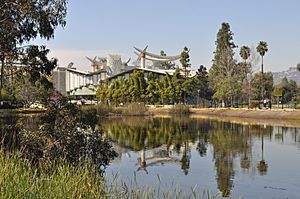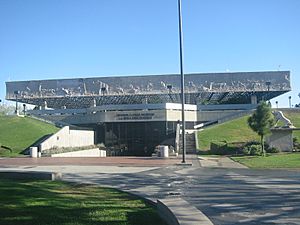Hancock Park facts for kids
Quick facts for kids Hancock Park |
|
|---|---|

Hancock Park, with tar pits and LACMA
|
|
| Lua error in Module:Location_map at line 420: attempt to index field 'wikibase' (a nil value). | |
| Type | Urban park |
| Location | 5800 block of Wilshire Blvd, Miracle Mile, Los Angeles, California |
| Operated by | Los Angeles Department of Recreation & Parks |
| Official name: Hancock Park La Brea | |
| Reference #: | 170 |
Hancock Park is a cool city park located in the Miracle Mile area of Los Angeles, California. It's a great place to visit if you're interested in history and science!
This park is home to some amazing places. You can explore the famous La Brea Tar Pits. There's also the George C. Page Museum of La Brea Discoveries. This museum shows off incredible fossils from the Ice Age. These fossils are from prehistoric animals that got stuck in the tar pits long ago. The park also includes the Los Angeles County Museum of Art (LACMA). These spots are some of the most popular attractions in Los Angeles.
Contents
Exploring Hancock Park's Features
Hancock Park offers open spaces and pretty landscaped areas. It's perfect for walking, having a picnic, or just relaxing. The park is on Wilshire Boulevard, near Fairfax Avenue. It covers a large city block and surrounds two big museums. The Park La Brea complex is just across 6th Street to the north. It's important to know that this park is not in the Hancock Park neighborhood. That neighborhood is about 1 mile (1.6 km) away.

Hancock Park is where you'll find the famous La Brea Tar Pits. It's also home to the George C. Page Museum of La Brea Discoveries. This museum is managed by the Natural History Museum of Los Angeles County. Plus, the park has the Los Angeles County Museum of Art (LACMA). LACMA has many buildings and beautiful sculpture gardens.
Discovering Ice Age Fossils
The park has a special place called the Observation Pit. It was built in 1952. This pit holds many large Ice Age fossils found in the tar pits. It reopened in 2014 after being closed for many years. Now, it's part of the Page Museum's new Excavator Tour.
Another cool spot is Pit 91. This area also reopened in 2014. Scientists dig for fossils here, and you can watch them work! Pit 91 had closed in 2006. This was so scientists could focus on new fossils. These new fossils were found when LACMA built a new underground parking garage. One amazing find was a nearly complete skeleton of a Columbian mammoth.
The Prehistoric Garden
The Pleistocene Garden in the park is like a time machine! It shows what the area looked like long ago. This garden recreates the ancient landscape of Hancock Park. It features plants that grew in the Los Angeles Basin 10,000 to 40,000 years ago. Scientists spent 35 years researching plants from the Pit 91 fossil excavation. The garden includes plants from four different natural areas. These are Coastal sage scrub, Riparian (riverbank), Deep Canyon California oak woodlands, and California montane chaparral.
History of Hancock Park
Hancock Park was created in 1924. A man named George Allan Hancock gave 23 acres of his family's ranch to Los Angeles County. He said the park must be kept safe. He also wanted the fossils to be shown properly.
The park is named after George Hancock. He was a pioneer in the California petroleum industry. He understood how important the fossils were. These fossils were found in the sticky tar pits. George inherited the 3,000-acre Rancho La Brea in 1883. This land included the famous La Brea tar pits. He found animal bones when he was digging for oil there.
Early Discoveries and Scientific Attention
For a long time, people thought the bones found in the tar pits were from farm animals. They also thought they were from local wild animals. But in 1875, a scientist named William Denton wrote about finding bones of extinct animals at Rancho La Brea.
It wasn't until 1901 that the bones were truly studied. William Warren Orcutt, a geologist from Los Angeles, examined bones he collected himself. Orcutt found bones of saber-toothed cats, dire wolfs, ground sloths, and other fossils. His discoveries made scientists realize how valuable the La Brea Tar Pits were. They helped us understand the ancient plants and animals of North America during the late Pleistocene era. Orcutt later gave his fossil collection to the University of California.
Hancock Park is recognized as California Historical Landmark #170. The La Brea Tar Pits are also a special U.S. National Natural Landmark.
California Historical Landmark Marker
There is a special marker at the park. It is California Historical Landmark NO. 170. It says:
- NO. 170 HANCOCK PARK LA BREA - Thousands of prehistoric animal bones were found here. These animals got stuck in tar pools during the Ice Age. The tar bubbled up from under the ground. The first mention of these pools was in 1769 by Gaspar de Portolá. The land was part of the 1840 Rancho La Brea land grant. Scientists from the University of California first started digging here in 1906. Captain G. Allan Hancock gave this site to Los Angeles County in 1916. He wanted it to become a scientific monument.


